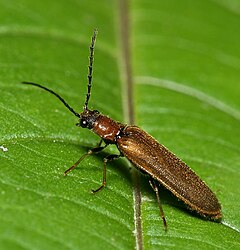Elateroidea
| Elateroidea Temporal range:
| |
|---|---|

| |
| Denticollis linearis, a click beetle (Elateridae) | |
| Scientific classification | |
| Domain: | Eukaryota |
| Kingdom: | Animalia |
| Phylum: | Arthropoda |
| Class: | Insecta |
| Order: | Coleoptera |
| Suborder: | Polyphaga |
| Infraorder: | Elateriformia |
| Superfamily: | Elateroidea Leach, 1815 |
| Families | |
|
About 15-20, see text | |



The Elateroidea are a large superfamily of beetles. It contains the familiar click beetles, fireflies, and soldier beetles and their relatives. It consists of about 25,000 species.[1]
Description
[edit]Elateroidea is a morphologically diverse group, including hard-bodied beetles with 5 abdominal ventrites, soft-bodied beetles with 7-8 ventrites connected with membranes (formerly known as cantharoids), and beetles with intermediate forms.[2] They have a range of sizes and colours, but in terms of shape, they are usually narrow and parallel-sided as adults.[3]
Many of the sclerotised elateroids (Cerophytidae, Eucnemidae, Throscidae, Elateridae) have a clicking mechanism.[4] This is a peg on the prothorax which fits into a cavity in the mesothorax. When a click beetle bends its body, the peg snaps into the cavity, causing the beetle's body to straighten so suddenly that it jumps into the air.[5]
Most beetles capable of bioluminescence are in the Elateroidea, in the families Lampyridae (~2000 species), Phengodidae (~200 species), Rhagophthalmidae (100 species) and Elateridae (>100 species).[4]
Females in several lineages, including Lycidae, Lampyridae, Phengogidae and Rhagophthalmidae, do not pupate and remain in a larval form. This trait is estimated to have evolved independently at least three times within the superfamily.[6]
Some Elateroidea, including species of Cantharidae[7] and Lycidae,[8] have bright aposematic colours to signal to predators that they are poisonous and so should not be eaten.
Families
[edit]The validity and relationships of some families, such as Podabrocephalidae are not fully resolved. The family Rhinorhipidae has recently been removed to its own superfamily, with evidence that it is a basal taxon within Elateriformia dating to an Upper Triassic/Lower Jurassic split from other extant beetle lineages.[9]
- Artematopodidae Lacordaire, 1857 – soft-bodied plant beetles (= Eurypogonidae)
- Brachypsectridae Leconte & Horn, 1883 – Texas beetles
- Cantharidae Imhoff, 1856 – soldier beetles
- Cerophytidae Latreille, 1834 – rare click beetles
- Elateridae Leach, 1815 – click beetles (including Ampedidae, Balgidae, Dicronychidae, Drilidae, Lissomidae, Plastoceridae, Prosternidae, Protelateridae, Pyrophoridae, Synaptidae)
- Eucnemidae Eschscholtz, 1829 – false click beetles (including Anischiidae and Perothopidae)
- Iberobaeniidae Bocak et al., 2016
- Jurasaidae Rosa, Costa, Klamp & Kundrata, 2020
- Lycidae – net-winged beetles
- Omethidae LeConte, 1861 – false firefly beetles (including Telegeusidae)
- Throscidae Laporte, 1840 – false metallic wood-boring beetles (= Trixagidae)
- †Mysteriomorphidae Alekseev and Ellenberger, 2019 (Cretaceous)
- Lampyroid clade
- †Cretophengodidae Li, Kundrata, Tihelka & Cai, 2021 (Cretaceous)
- Lampyridae Latreille, 1817 – firefly beetles
- Phengodidae LeConte 1861 – glowworm beetles (including Cydistinae[1])
- Rhagophthalmidae Olivier, 1907 (sometimes in Phengodidae, might belong in Lampyridae)
- Sinopyrophoridae Bi & Li, 2019[4][10]
- Incertae sedis:
- †Anoeuma Li, Kundrata & Cai, 2022 (Cretaceous)
Phylogeny
[edit]Some morphological and molecular phylogenetic analyses find that Byrrhoidea is either a monophyletic or paraphyletic group closely related to Elateroidea.[11]
Based on Kusy et al. 2018[12] and 2020[4]
| Elateroidea | |
References
[edit]- ^ a b Kundrata, Robin; Blank, Stephan M; Prosvirov, Alexander S; Sormova, Eliska; Gimmel, Matthew L; Vondráček, Dominik; Kramp, Katja (2019-10-19). "One less mystery in Coleoptera systematics: the position of Cydistinae (Elateriformia incertae sedis) resolved by multigene phylogenetic analysis". Zoological Journal of the Linnean Society. 20 (4): 1259–1277. doi:10.1093/zoolinnean/zlz104. ISSN 0024-4082.
- ^ Li, Yan-Da; Kundrata, Robin; Packova, Gabriela; Huang, Di-Ying; Cai, Chen-Yang (2021-11-09). "An unusual elateroid lineage from mid-Cretaceous Burmese amber (Coleoptera: Elateroidea)". Scientific Reports. 11 (1): 21985. Bibcode:2021NatSR..1121985L. doi:10.1038/s41598-021-01398-w. ISSN 2045-2322. PMC 8578672. PMID 34753998. S2CID 243940384.
- ^ "Superfamily Elateroidea - Click Beetle, Lycid Beetles and Soldier Beetles". www.brisbaneinsects.com. Retrieved 2022-09-30.
- ^ a b c d Kusy, Dominik; He, Jin-Wu; Bybee, Seth M.; Motyka, Michal; Bi, Wen-Xuan; Podsiadlowski, Lars; Li, Xue-Yan; Bocak, Ladislav (2020-08-25). "Phylogenomic relationships of bioluminescent elateroids define the 'lampyroid' clade with clicking Sinopyrophoridae as its earliest member". Systematic Entomology. 46. Wiley: 111–123. doi:10.1111/syen.12451. ISSN 0307-6970.
- ^ "Elateridae (click beetles)". www.ento.csiro.au. Retrieved 2022-09-30.
- ^ Mcmahon, Dino P.; Hayward, Alexander (2016). "Why grow up? A perspective on insect strategies to avoid metamorphosis: Insect strategies to avoid metamorphosis". Ecological Entomology. 41 (5): 505–515. doi:10.1111/een.12313. S2CID 86908583.
- ^ "Family Cantharidae - Soldier Beetles". bugguide.net. Retrieved 2022-09-30.
- ^ "Family Lycidae - Net-winged Beetles". bugguide.net. Retrieved 2022-09-30.
- ^ Kusy, Dominik; Motyka, Michal; Andujar, Carmelo; Bocek, Matej; Masek, Michal; Sklenarova, Katerina; Kokas, Filip; Bocakova, Milada; Vogler, Alfried P.; Bocak, Ladislav (2018-05-02). "Genome sequencing of Rhinorhipus Lawrence exposes an early branch of the Coleoptera". Frontiers in Zoology. 15 (1): 21. doi:10.1186/s12983-018-0262-0. ISSN 1742-9994. PMC 5930637. PMID 29743928.
- ^ Bi, Wen-Xuan; He, Jin-Wu; Chen, Chang-Chin; Kundrata, Robin; Li, Xue-Yan (2019-07-17). "Sinopyrophorinae, a new subfamily of Elateridae (Coleoptera, Elateroidea) with the first record of a luminous click beetle in Asia and evidence for multiple origins of bioluminescence in Elateridae". ZooKeys (864). Pensoft Publishers: 79–97. Bibcode:2019ZooK..864...79B. doi:10.3897/zookeys.864.26689. ISSN 1313-2970. PMC 6656784. PMID 31363346.
- ^ Beutel, R. G. (1995). "Phylogenetic analysis of Elateriformia (Coleoptera: Polyphaga) based on larval characters". Journal of Zoological Systematics and Evolutionary Research. 33 (3–4): 145–171. doi:10.1111/j.1439-0469.1995.tb00969.x. ISSN 1439-0469.
- ^ Kusy, Dominik; Motyka, Michal; Bocek, Matej; Vogler, Alfried P.; Bocak, Ladislav (2018-11-20). "Genome sequences identify three families of Coleoptera as morphologically derived click beetles (Elateridae)". Scientific Reports. 8 (1). Springer Science and Business Media LLC: 17084. Bibcode:2018NatSR...817084K. doi:10.1038/s41598-018-35328-0. ISSN 2045-2322. PMC 6244081. PMID 30459416.
